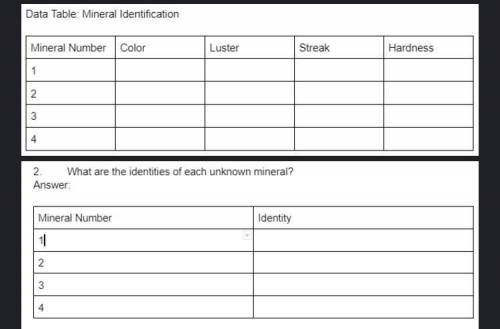
Biology, 28.11.2021 01:00 lisamiller
1. Complete the following Data Table as you conduct the lab.
Data Table: Mineral Identification (PICTURES OF BOTH TABLES ARE INCLUDED IN ONE PICTURE) (AND THE MINERAL PICTURES ARE INCLUDED TOO)
2. What are the identities of each unknown mineral?
3. Why was it important to examine both the color and the streak of your minerals?
4. Is luster a good characteristic to use for the identification of minerals? Why or why not?
5. You have been given a sample of quartz, which has a hardness of 7. How can you use this mineral to determine the hardness of other minerals?
6. Which property or properties did you find most useful in the identification of the mineral samples? Which properties were less useful? Be specific in your explanation.






Answers: 2


Other questions on the subject: Biology

Biology, 22.06.2019 02:00, aredding7016
The accompanying figure shows the percent of selected dna sequences that match between a chimpanzee and other primates. these data support the hypothesis that the figure shows the percentage of selected d n a sequences that match between the chimpanzee and other primates. the human has an almost 98 percent match, the gorilla has an almost 97 percent match, the orangutan has a 96 percent match, the gibbon has an almost 95 percent match, and the old world monkey has an almost 92 percent match. the accompanying figure shows the percent of selected dna sequences that match between a chimpanzee and other primates. these data support the hypothesis that the figure shows the percentage of selected d n a sequences that match between the chimpanzee and other primates. the human has an almost 98 percent match, the gorilla has an almost 97 percent match, the orangutan has a 96 percent match, the gibbon has an almost 95 percent match, and the old world monkey has an almost 92 percent match. chimpanzees and gibbons are the most closely related the chimpanzee's closest surviving relative is humans orangutans are the primates least closely related to chimpanzees old world monkeys and gibbons are the most closely related
Answers: 1

Biology, 22.06.2019 06:30, denisturcios18
Mitosis creates two identical daughter cells from one parent cell creates four nonidentical daughter cells from one parent cell is the most common type of reproduction for bacteria is the process by which male and female reproductive cells are created
Answers: 1


Biology, 22.06.2019 10:30, lexiemornelas
During a fierce storm a large number of tall trees on an island are uprooted by the wind and die. most of the trees on the island are now short trees and produce seeds that grow into short trees. what concept is shown in this example? question 5 options: natural selection artificial selection genetic engineering gene splicing
Answers: 2
You know the right answer?
1. Complete the following Data Table as you conduct the lab.
Data Table: Mineral Identification (P...
Questions in other subjects:



SAT, 05.02.2020 09:45



Mathematics, 05.02.2020 09:45

World Languages, 05.02.2020 09:45

History, 05.02.2020 09:45


Mathematics, 05.02.2020 09:45



